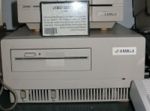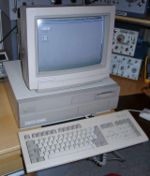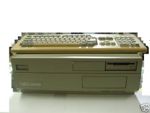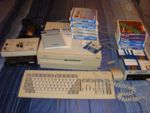Difference between revisions of "Amiga"
(→Amiga 600) |
m (+cat) |
||
| (One intermediate revision by one other user not shown) | |||
| Line 50: | Line 50: | ||
=== Amiga 1500 === | === Amiga 1500 === | ||
[[Image:Amiga 1500.jpg|150px|right|thumb|An Amiga 1500]] | [[Image:Amiga 1500.jpg|150px|right|thumb|An Amiga 1500]] | ||
| − | This Amiga was a desktop model that | + | This Amiga was a desktop model that was pretty much an Amiga 2000 with dual floppy drives. The motherboard was identical to the Amiga 2000. The 1500 did cost less, and was possibly released to try to block an upgrade product from using the moniker [http://www.amiga-hardware.com/showhardware.cgi?HARDID=6 A1500]. |
| − | I think this model was primary sold in | + | I think this model was primary sold in the UK as a 'budget' 2000. |
I'm really not that sure about this model's popularity. | I'm really not that sure about this model's popularity. | ||
| Line 140: | Line 140: | ||
The most popular emulator for the Commodore Amiga is [[UAE]]. | The most popular emulator for the Commodore Amiga is [[UAE]]. | ||
| − | {{stub}} | + | {{semi-stub}} |
| + | |||
| + | [[Category: Commodore Computers]] | ||
Latest revision as of 00:41, 17 December 2018
The Amiga, which was sold by Commodore was one of the most underrated computers of the 1990's.
The Amiga was designed by Jay Minor and was originally developed as the Loraine under the brand 'Hi-toro'. The Amiga is noted for its use of the 68000 CPU, and a set of custom coprocessors.
Originally Atari had funded the later stages of the Amiga's development but they had lowballed the final price. Hi-Toro shopped themselves, and Commodore had found an opportunity to snatch the next generation machine from Atari.
Models
Amiga 1000
The Amiga 1000 was the first model to ship from Commodore. The Amiga 1000 featured a keyboard that could slide under the unit so it wouldn't take up desk space when it was not in use. Also the ports on the back of the Amiga 1000 were all wired BACKWARDS from industry standards as people apparently at the time didn't know if they were allowed to use the standard parallel & serial ports without worrying about a lawsuit. Therefore if you do acquire an Amiga 1000 you'll need special cables if you expect to print from it.
The Amiga 1000 introduced the floppy port that is found in the rest of the Amigas that powers the drive, and automatically sets up its drive id on the floppy bus.
The Amiga 1000 shipped with 256KB of RAM, and an additional 256KB of RAM configured as a "WCS" or writeable control store. Much like how a VAX 11/780 boots, there is enough ROM to read from a secondary storage unit (floppy) where the kickstart OS is loaded into this special WCS to emulate a ROM once it is loaded. At the time of the Amiga 1000's launch it was a rushed product and Commodore felt confident it could just ship updated disks to people, and provide them to dealers etc... All other Amiga's contain their OS in a ROM upgrade, except the Amiga 3000 which used the 68030's MMU to emulate a WCS.
I recall that standard Commodore 64/Atari joysticks would work in every model of the Amiga, including the 1000. Typically a mouse is plugged into port 1, and a joystick in port 2.
The Amiga 1000 had an expansion slot on the site (the pinout was the reverse from the Amiga 500) allowing the addition of RAM expansion units, and the 'sidecar'.
The sidecar was an interesting periphial, as it was basically a full IBM XT that would use the Amiga for its keyboard and emulated display (CGA or MGA). The sidecar would typically ship with a 5 1/4" floppy drive, MS-DOS (OEM'd to Commodore, naturally), and include some expansion slots, RAM etc. This being a hardware solution would allow the Amiga to run MS-DOS programs, not only at full speed, but in a window, and of course allow the 68000 CPU to do something at the same time. However the sidecars were VERY expensive, about the cost of a comparably configured IBM XT computer. I think it was too small for something like an Intel inboard 386 expansion card, nor did it have space to mount a hard disk.
Amiga 500
The Amiga 500 was a Commodore 64 style influenced Amiga. It included 512KB of system RAM, and a single floppy drive built in. The chipset used in the Amiga 500 would be known as the 'OCS'. It also featured a single expansion slot on the left side, that could allow accelerators, hard disks, scsi ports (etc) to be added to the system in a 'side car' like expansion.
The Amiga 500 shipped with 512KB of RAM.
The Amiga 500 did not feature a clock, however it was a common addon with a memory expansion card that would fit in the 'trapdoor' slot. Typically these slot cards could add anywhere from another 512KB of RAM, up to 3.5MB of RAM.
This was perhaps one of the most popular models of the Amiga, and was very popular in the 1980's.
Amiga 600
This should have been a low cost version of the 500, with the updated ECS chipset, however it wound up costing more than the Amiga 500. The Amiga 600 replaced the 500, at the time of the 1200's release. One of the big differences in the Amiga 600/1200 was the move to all surface mount chips that would increase the reliability of the boards. However this also meant it was extremely difficult to repair the boards as none of the chips were socketed. The Amiga 600 also included a PCMCIA slot, and an IDE controller. However the software to boot from the IDE interface was NOT included in the default ROMS that shipped with the Amiga 600 (37.299). The Amiga 600 HD variant included a 2.5 inch 40Mb IDE disk, and shipped with the firmware version 37.300 . A later firmware chip was made available, 37.350 which had support for hard disks up to 4GB.
Another major dissapointment was that the Amiga 600 had the same basic specifications as the Amiga 500. Releasing a machine with a 7Mhz 68000 around 1992 seemed crazy as Apple had moved on to Quadras and even the PC market was in the double digit MHz CPUs.
One really has to wonder why this machine was released at all, or it just started to show that manufacturing 'low cost' machines was beyond the capabilities of Commodore.
Amiga 1200
The Amiga 1200 used a 68020 CPU, and the new AGA chipset that also shipped in the Amiga 4000. It also was a single 'wedge' like the Amiga 600/500.
The Amiga 1200 used surface mount chips, much like the Amiga 600, and it too also had a PCMCIA slot, and an IDE controller port along with the mounting space for a 2.5" IDE disk.
There were upgrade modules to expand the 1200 up to a 68060, and some PowerPC modules as well.
Amiga 1500
This Amiga was a desktop model that was pretty much an Amiga 2000 with dual floppy drives. The motherboard was identical to the Amiga 2000. The 1500 did cost less, and was possibly released to try to block an upgrade product from using the moniker A1500.
I think this model was primary sold in the UK as a 'budget' 2000.
I'm really not that sure about this model's popularity.
Amiga 2000
The Amiga 2000 was a desktop version of the Amiga 500. It featured 5 Zorro expansion slots, a processor slot and 4 ISA slots (2 ISA & Zorro slots overlapped). The Amiga 2000 could be outfitted with a 'bridgecard' that would bridge between the Zorro slots, and the ISA slots. The Amiga 2000 was compatible with the XT, 286 & 386sx model bridgecards. Like the sidecar the bridgecards were basically a complete IBM PC on a slot card that would redirect their video & keyboard to a process on the AmigaDOS side. Much like the sidecar the bridgecard CPU was independent of the Amiga CPU, and would allow people to fully multitask between the two systems.
The Amiga 2000 was equipped with the same CPU as the Amiga 500. Considering the price difference most people gravitated towards the Amiga 500, as the 2000 was VERY expensive, and Zorro cards were limited to bridgecards (which cost nearly as much as a physical IBM PC), hard disk controllers & memory cards. The Amiga 2000 could also be outfitted with very expensive CPU accelerators that would disable the primary 68000 on boot. Since the Amiga 2000 was basically an Amiga 500 with slots, the Amiga 2000 could also use the same 3rd party CPU accelerators that came in a daughter board form factor.
Early versions of the Amiga 2000 were plagued with buggy motherboards, the 'good' versions are 4.2 & 6.1 ... I think.
The Amiga 2000 included a battery backed realtime clock. However the battery was soldered to the motherboard, which over the years tends to leak. Many motherboards have been destroyed as the corrosion from these batteries not only eat traces, but bubble the layers of the board destroying them.
This has become a problem for all of the desktop machines that Commodore made.
Amiga 2000HD
The Amiga 2000HD was a Amiga 2000, that would have included the A2901, Zorro MFM hard disk controller, and a 'fixed disk' of varying capacity.. Typically 20MB, 40MB etc.. From what i have seen, they were Seagate 5 1/4" disks that would take up the only 5 1/4" bay in the Amiga 2000 preventing the installation of a bridgeboard's 5 1/4" floppy disk what was typical of the kit.
I'm pretty sure any reseller that installed the 2091 & the hard disk could slap on the 2000HD label on any typical 2000.
Amiga 2500
I recall this Amiga being an Amiga 2500HD with a 68020 accelerator pre-installed from the factory. Otherwise it was an upgraded 2000.
Amiga 3000
The Amiga 3000 was a 68030 Amiga that used the ECS chipset, and was fully 32bit. The Amiga 3000 used ZIP RAM instead of DIP, at the time allowing for faster memory access. However the industry at large would shun the ZIP chip, and instead move to the SIMM. This is a MAJOR obstacle for anyone trying to upgrade an Amiga 3000 today.
Another thing worth noting is that the first Amiga 3000's shipped before the OS was ready. They have a beta version of the unrelease 1.4 in ROM. It is used primarily for loading either a patched version of 1.3 or 2.0 from the hard disk. As the os wasn't quite ready, Commodore shipped a number of upgrades on floppy that would replace the kickstart files that were on a separate partition on the hard disk.
Amiga 3000UX
The 3000UX was an Amiga 3000 that included a SCSI tape drive, and came with Commodore's SYSVr4 port,AMIX. This model could have saved the company as SUN wanted to rebrand the machine, and make MILLIONS with it. Naturally Commodore declined such a deal. It is worth noting that Commodore UNIX could run on any other Amiga 3000, and there are some 'hacks' to copy the tape image onto a second hard disk, and allow install without requiring the tape, or the tape drive.
The machine that would have been rebranded by SUN became the Amiga_3000T.
Amiga 3000T
The Amiga 3000T was basically the same as the Amiga 3000, however it was in a Tower case, giving more room for disk drives, and expansion slots. The Amiga 3000T mother board had 1 Video slot, 1 CPU slot, 5 Zorro III slots, and 2 16 bit ISA slots (that overlap 2 of the Zorro slots).
This is a very RARE model.
Amiga 4000
The Amiga 4000 was based around the 68040 cpu, and the AGA chipset. This was the desktop model.
Amiga 4000T
The Amiga 4000T was in the same idea as the 3000T. This was just an Amiga 4000 in a tower case. Commodore went bankrupt shortly after the introduction of the Amiga 4000T. Like the 3000T these are very rare to find.
The chipsets
These chips were to offload as much of the IO from the main 68000 as possible freeing it for CPU only work. It was a novel idea at the time as most machines only had room for a floating point (math) coprocessor, such as an 8087, or 688881. The chips include:
OCS
OCS stands for Original Chip Set, as this designation came when the Amiga 3000 introduced the ECS or Enhanced chipset.
The three chips were the Agnus, Denise, and Paula chips.
Agnus controlled the chipset's memory access, and implemented a bit blitter in hardware. The original version of the chip could access 512KB of 'chip RAM', the fat Angus could up that to 1024KB, and the fatter Angus up to two megabytes.
Denise was the video co-processor.
And finally Paula was the audio co-processor.
ECS
The ECS, or Enhanced Chip Set, included support for up to 2MB of Chip memory, and additional video modes.
AGA
The Operating System
AmigaDOS was a port of TripOS to the 68000 CPU. The GUI intuition ran on top of it.
Expansion
Various expansion slot types found in the Amiga line of computers.
Zorro I
This was the slot type of the Amiga 1000.
Zorro II
These slots were found in the Amiga 1500,Amiga 2000 and Amiga 2500. I am pretty sure these were 16bit, as the 68000 had an external 16bit data bus, and a 24bit address bus... I do know that they featured 'autoconfigure' so that each board would configure its own IO, DMA & IRQ assignments into the BUS, and could provide an AmigaDOS driver in ROM to drive each peripherial.
Zorro III
I'm pretty sure these are the 32bit slots found in the Amiga 3000, Amiga 3000T, and the Amiga 4000 series of computers.
Emulators
The most popular emulator for the Commodore Amiga is UAE.










